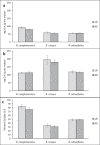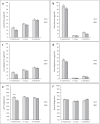Comparing the Above and Below-Ground Chemical Defences of Three Rumex Species Between Their Native and Introduced Provenances
- PMID: 37121960
- PMCID: PMC10495513
- DOI: 10.1007/s10886-023-01427-0
Comparing the Above and Below-Ground Chemical Defences of Three Rumex Species Between Their Native and Introduced Provenances
Abstract
Compared to their native range, non-native plants often experience reduced levels of herbivory in the introduced range. This may result in reduced pressure to produce chemical defences that act against herbivores. We measured the most abundant secondary metabolites found in Rumex spp., namely oxalates, phenols and tannins. To test this hypothesis, we compared native (UK) and introduced (NZ) provenances of three different Rumex species (R. obtusifolius, R. crispus and R. conglomeratus, Polygonaceae) to assess whether any significant differences existed in their levels of chemical defences in either leaves and roots. All three species have previously been shown to support a lower diversity of insect herbivores and experience less herbivory in the introduced range. We further examined leaf herbivory on plants from both provenances when grown together in a common garden experiment in New Zealand to test whether any differences in damage might be consistent with variation in the quantity of chemical defences. We found that two Rumex species (R. obtusifolius and R. crispus) showed no evidence for a reduction in chemical defences, while a third (R. conglomeratus) showed only limited evidence. The common garden experiment revealed that the leaves analysed had low levels of herbivory (~ 0.5%) with no differences in damage between provenances for any of the three study species. Roots tended to have a higher concentration of tannins than shoots, but again showed no difference between the provenances. As such, the findings of this study provide no evidence for lower plant investments in chemical defences, suggesting that other factors explain the success of Rumex spp. in New Zealand.
Keywords: Alien species; Chemical defences; Introduced; Native; Plant invasion; Weeds.
© 2023. The Author(s).
Conflict of interest statement
The authors declare no competing interests.
The authors have no conflicts of interest to declare that are relevant to the content of this article.
Figures




References
MeSH terms
Substances
LinkOut - more resources
Full Text Sources
Research Materials
Miscellaneous

